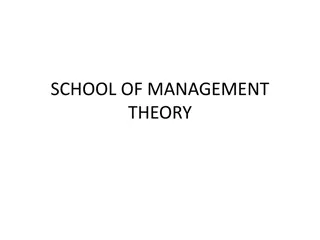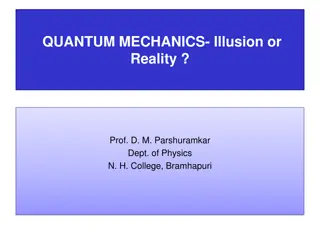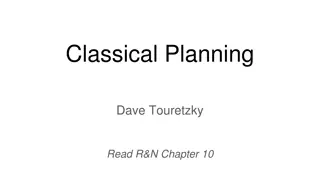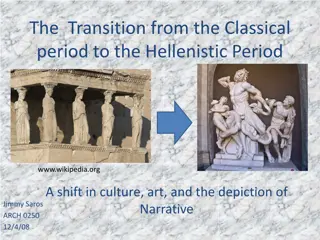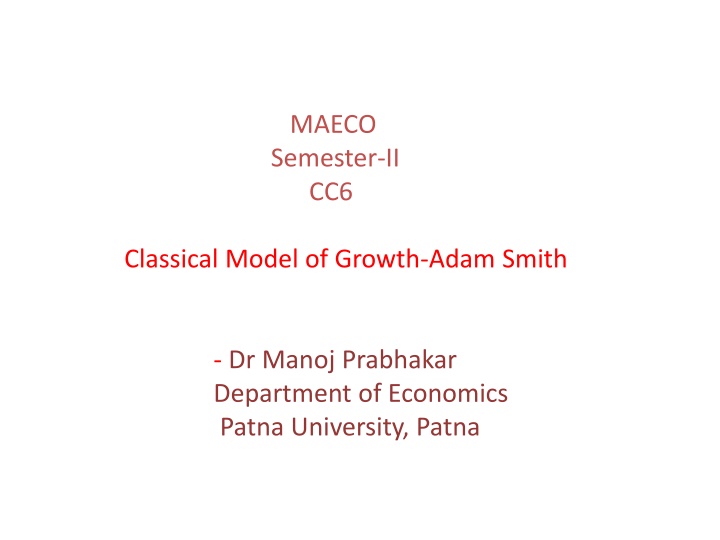
Classical Model of Economic Growth by Adam Smith
Learn about the Classical Model of Growth as proposed by Adam Smith, emphasizing laissez-faire economics, profit as an incentive for investment, and Adam Smith's ideas on economic growth. Explore the key features of classical models and understand how profits, capital accumulation, and wages influence economic progress.
Download Presentation

Please find below an Image/Link to download the presentation.
The content on the website is provided AS IS for your information and personal use only. It may not be sold, licensed, or shared on other websites without obtaining consent from the author. If you encounter any issues during the download, it is possible that the publisher has removed the file from their server.
You are allowed to download the files provided on this website for personal or commercial use, subject to the condition that they are used lawfully. All files are the property of their respective owners.
The content on the website is provided AS IS for your information and personal use only. It may not be sold, licensed, or shared on other websites without obtaining consent from the author.
E N D
Presentation Transcript
MAECO Semester-II CC6 Classical Model of Growth-Adam Smith - Dr Manoj Prabhakar Department of Economics Patna University, Patna
Contents: Features of Classical Models Adam Smith on Economic Growth Adam Smith s Main Ideas of Economic Growth Growth Process in Adam Smith s Model Concluding Remarks
Feature of Classical Models of Growth: Laissez Fair- the existence of an automatic free market perfectly competitive economy which is free from any government interference. The maximisation of national income which is done only by the invisible hand Capital accumulation as the key to economic progress. Classical economists emphasised on larger savings. Only capitalists and lanlords have the capability of saving. The working class gets wages equal to the subsistence level is incapable of saving.
Profit- as Incentive to Investment: The larger the profits, the greater the capital accumulation and investment. Declining Tendency of Profit : Increase in profit is not a continuous process. When competition increases for larger capital accumulation , the profit tends to decline. To Adam Smith, there will be an incrase in wages due to competition among capitalists. To Ricardo, when wages and rent use to increase with the increase in the price of corn , profit declines.
Once profits starts declining, this continues till profit become zero ,population and capital accumulation stop increasing and the wage rate reaches the subsistence level. It is the scarcity of natural resources that finally stops growth and leads the economy to stationary state.
Adam Smith on Economic Growth: Adam Smith is known as the Father of political economy and also the founder of classical school of economics. Adam Smith s monumental work An Enquiry into the Nature and Causes of of the Wealth of Nations was a pioneer attempt to explain the process of economic progress in general and causes of capitalistic development in particular. Adam Smith recognised the existence of three factors of production, namely, labour, capital and land. His productionfunction may be expressed as Y = f( K, L, N) where K denotes stock of capital, L represents labour force and N stands for land.
Adam Smiths Main Ideas of Economic Growth: The main determinants of economic growth is capital formation and it is considered as an engine of development. Capiatal accumulation depends upon saving that is the difference between income and consumption. Laissez faire policy helps in maximising output and savings. Widen market promotes division of labour and specialisation increase labour productivity that increase in National Income and output. Economic development is not sudden or abrupt process, it is a gradual and cumulative process leading to the emergence of a stationary state.
Growth Process in Adam Smiths Model: Widening of Market Division of Labour Productivity * Economy grows like a tree. Increase in National Income and Output Saving Investment Economic Growth higher and higher
Adam Smiths idea about development influenced on the subsequent classical and neo-classical writers. His emphasis on capital accumulation in the development process has been the fundamental element and has been incorporated in contemporary growth theories. The concept of stationary state is an integral part of his development theory and his analysis is called the theory of growth and stagnation. Adam Smith s prescription in terms of division of labour, capital accumulation, expansion of markets and promotion of interests of farmers,traders and manufactures by the liberal government, very useful and conducive for economic development.
Concluding Remarks: Too much reliance on Smith s prescription and the absence of active State participation might push the underdeveloped countries to the brink of stagnation. Adam Smith has not suggested the way how the economy can come out of the stationary state. He appears to have explained the process of upswing and downswing. But no explation has been given as to how the downswing is converted into upswing and recovery or how pessimism is changed into optimism. Smith had no prescription to offer for preventing the economy into a stationary state.

